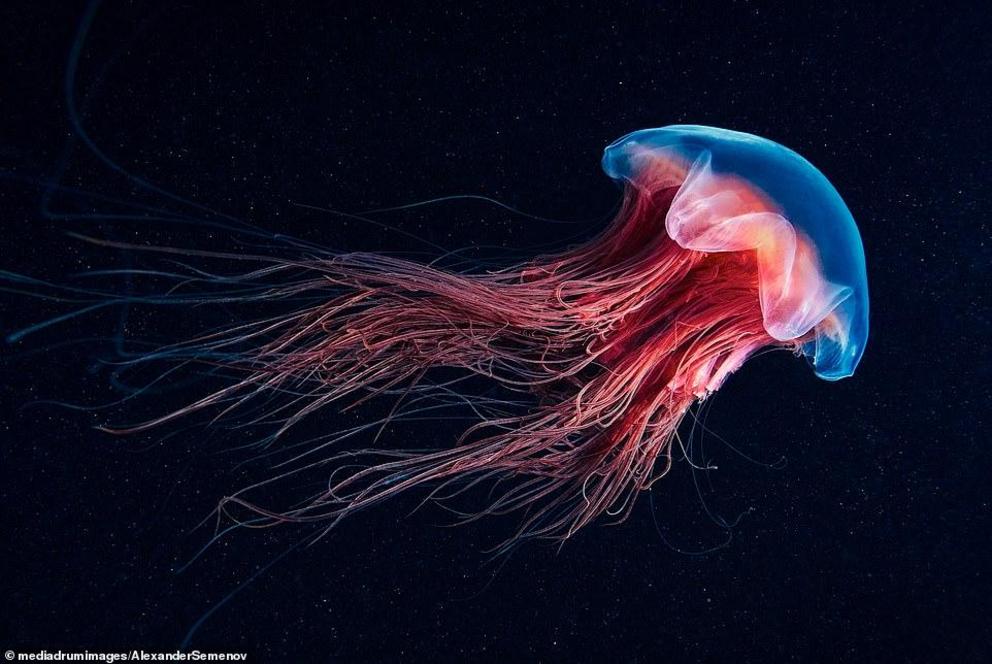Diver captures stunning images of 'underwater aliens' living in sub-zero conditions 500 feet below the White Sea near Russia
A diver braved sub-zero conditions to capture stunning images of 'underwater aliens' living 500 feet below the White Sea. Deep below the ice is an enchanted world of unique creatures such as the lion's mane jellyfish, which is the largest of its species in the world. Its tentacles can grow up to 120-feet long, which resemble wavy human hair that sits underside of its bell-shaped body.
- A marine biologist studied the enchanting world below the White Sea, one of the most remote on Earth
- Alexander Semenov dives 200ft using high-tech cameras to capture the creatures living 500ft below the sea
- The pictures show a lion's mane' jellyfish with a blue body and pink pink spaghetti-like tentacles
- There is also an intestine-like golden ragworm and a small invertebrate that resembles fairy lights
A diver braved sub-zero conditions to capture stunning images of 'underwater aliens' living 500 feet below the White Sea.
Alexander Semenov, a marine biologist from Moscow, Russia, spends just 40 minutes beneath the frigid waters reaching depths of 200 feet, but with the marvels of new technology he has the ability to photograph the deep-sea creatures.
The gallery includes a luminescent 'lion's mane' jellyfish with a blue body and pink spaghetti-like tentacles that measure over forty-nine-feet in length, an intestine-like golden ragworm and a small invertebrate that resembles fairy lights known as Euplokamis dunlopae - a tiny Arctic ctenophore.
'These creatures have floated in the vast open space for millions of years, over this time evolution has made so many totally weird life forms, I'm extremely lucky to see this world with my own eyes,' Semenov said.
The White Sea, where these pictures were taken, is one of the most remote and untouched places left on Earth.
The body of water is an inlet south of the Barents Sea, which resides on the northwest coast of Russia, and has a surface area of 34,700 square miles and depths that range from 197 feet to 1,115 feet.
The White Sea is one of the four seas named in English after common color terms—the others being the Black Sea, the Red Sea and the Yellow Sea.
Semenov's research center is located on the Karelian coast, was founded by a group of biologists from Moscow State University in 1938.
The facility is also off the grid, as there is no communication or an access road to the nearby village of Poyaknda, which is 10 miles away, and can only be accessed by boats in the summer or snowmobiles during the winter.
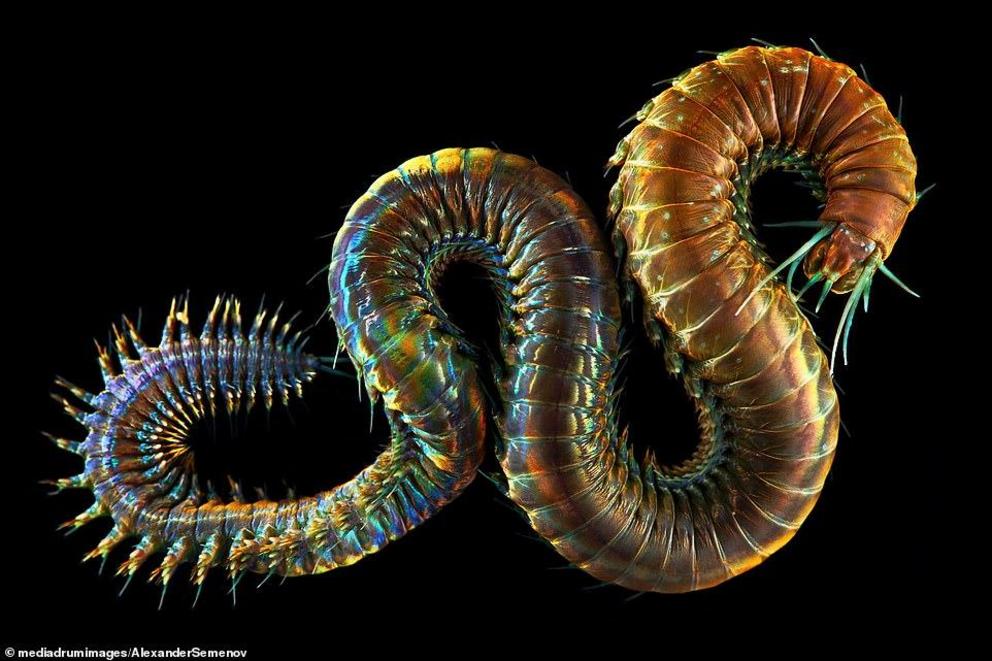 Pictured is an intestine-like golden ragworm. Some ragworm's settle only inside the skeletons of dead whales which have sunk to the bottom of the sea, while others live in burrows and use their huge jaws to catch small fish and drag them underground
Pictured is an intestine-like golden ragworm. Some ragworm's settle only inside the skeletons of dead whales which have sunk to the bottom of the sea, while others live in burrows and use their huge jaws to catch small fish and drag them underground
 Pictured is a small invertebrate that resembles fairy lights known as Euplokamis dunlopae - a tiny Arctic ctenophore. The White sea is covered by ice four to six months of the year, but Semenov is will to risk the sub-zero conditions to capture these stun
Pictured is a small invertebrate that resembles fairy lights known as Euplokamis dunlopae - a tiny Arctic ctenophore. The White sea is covered by ice four to six months of the year, but Semenov is will to risk the sub-zero conditions to capture these stun
'The White Sea is covered by ice for four to six months,' said Semenov.
'The biggest challenge is the tidal current, even if you hold a huge rock, an hour or so of diving can really sweep you away. In under thirty minutes you can be a mile from the point where you jumped in the water.
'When you dive under the ice this is extremely important to remember, because even with the safety rope you can be pulled out against the current - it's that strong.'
However, he is willing to risk the danger to fulfill his passion for documenting the striking differences between these who have evolved cut off from their cousins that live in warmer waters elsewhere in the world.
Deep below the ice is an enchanted world of unique creatures such as the lion's mane jellyfish, which is the largest of its species in the world.
Its tentacles can grow up to 120-feet long, which resemble wavy human hair that sits underside of its bell-shaped body, according to OCEANA.
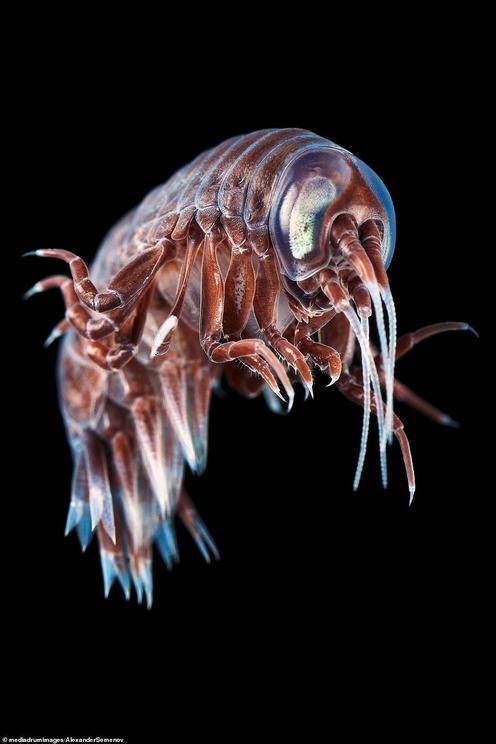 This pink Hyperia galba is a rare species of zooplankton, which is translucent and has prominent eyes that occupy the entire sides of its head
This pink Hyperia galba is a rare species of zooplankton, which is translucent and has prominent eyes that occupy the entire sides of its head
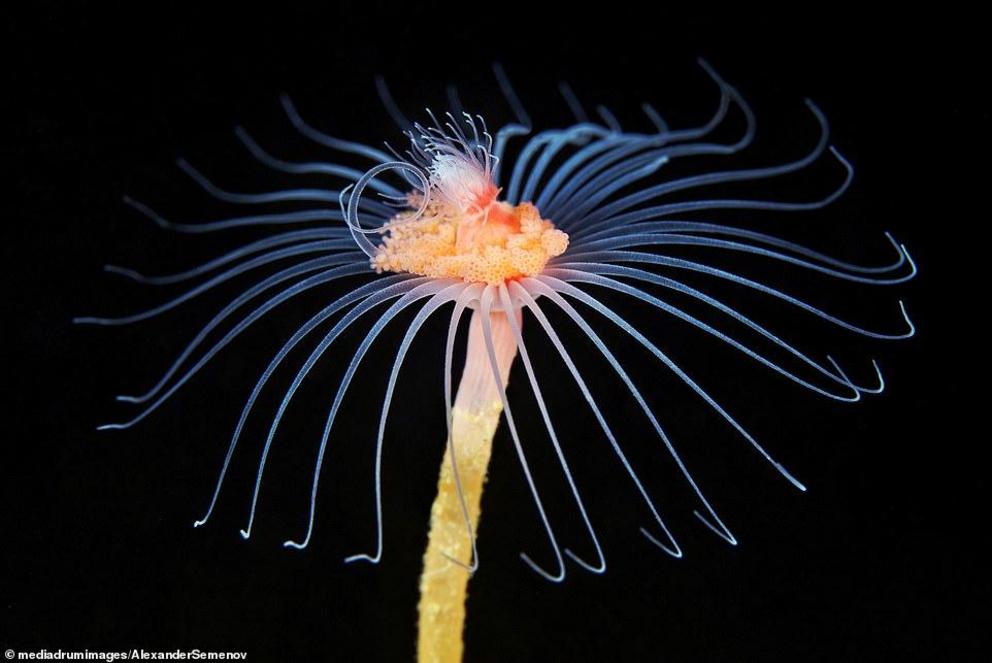 Hydrozoans take their name from ancient Greek, which are small, predatory animals. Some can be found living along or in a colony
Hydrozoans take their name from ancient Greek, which are small, predatory animals. Some can be found living along or in a colony
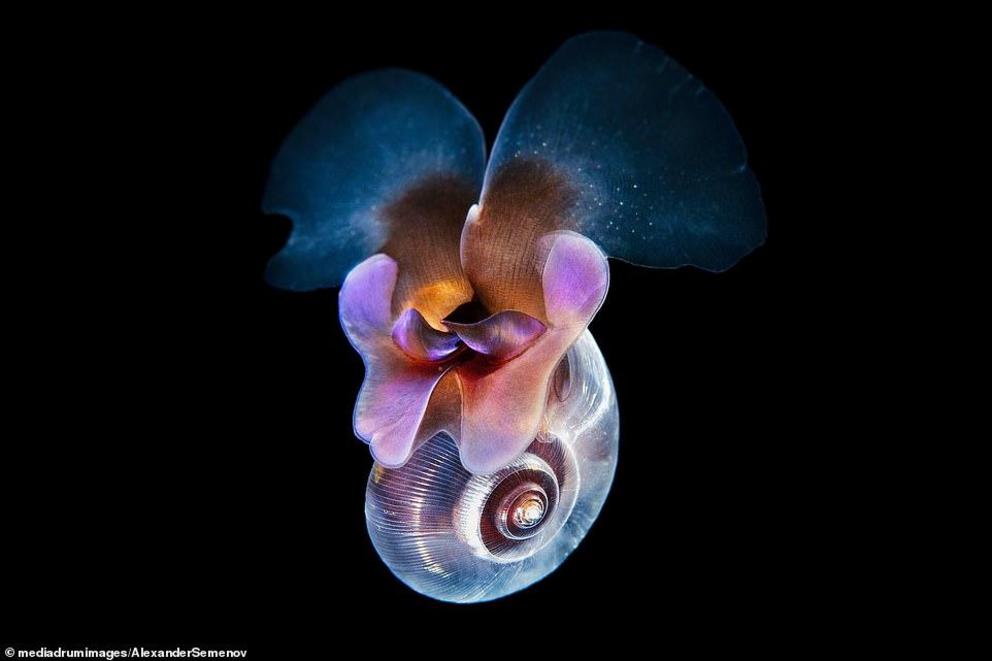 Limacina helicina is a swimming planktonic snail first discovered in 1675. These creatures also belong to the group commonly known as sea butterflies
Limacina helicina is a swimming planktonic snail first discovered in 1675. These creatures also belong to the group commonly known as sea butterflies
The mouth also sits on the underside, surrounded by tentacles that are divided into eight clusters of up to 150 tentacles each.
These tentacles are filled with a poison the jellyfish uses to stun prey in its grasp.
The lion's mane jellyfish also possess bioluminescent abilities, meaning it's able to produce its own light and glow in the dark underwater.
'When you see a lion's mane jellyfish (Cyanea capillata) with over three feet dome diameter and over forty-nine feet of tentacles, in complete darkness - it's amazing,' Semenov explained.
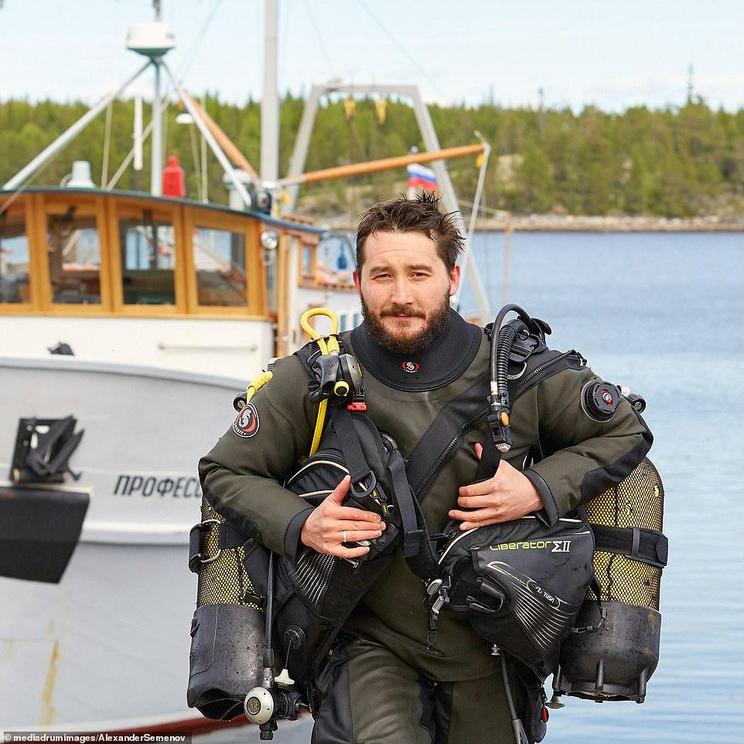 Alexander Semenov (pictured), a marine biologist from Moscow, Russia, spends just 40 minutes beneath the frigid waters reaching depths of 200 feet, but with the marvels of new technology he has the ability to photograph the deep-sea creatures
Alexander Semenov (pictured), a marine biologist from Moscow, Russia, spends just 40 minutes beneath the frigid waters reaching depths of 200 feet, but with the marvels of new technology he has the ability to photograph the deep-sea creatures
'There are many amazing facts about the ocean, and the deeper you go, the more you understand what is impressive and what is not.
'Some of the creatures can even reach over seven feet in dome size and their tentacles can measure up to one hundred and twenty feet. '
'Incredibly, these match the average height of a twelve-story building.'
He has also captured images of a pink Hyperia galba is a rare species of zooplankton, a Limacina helicina that a planktonic snail first discovered in 1675 and a Hydrozoans take their name from ancient Greek for water.

